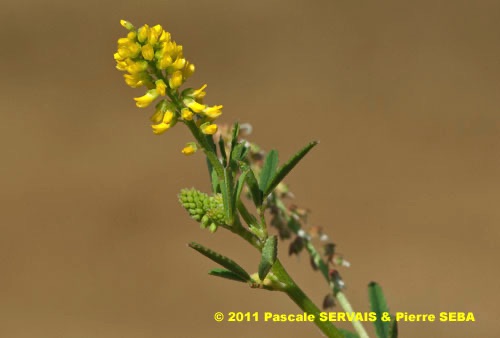
Melilotus indicus (L.) All.
Fam. : Fabaceae
© Pascale SERVAIS & Pierre SEBA, 2018. Tilo Botanica: Flore de Tilos et du Dodécanèse / Flora of Tilos and of the Dodecanese
English translation by Brenda Bradbury, Howard Bradbury and Stéphane Léonard
Plante herbacée, hermaphrodite, en touffe dressée, à tiges ramifiées, un peu côtelées.
Feuilles alternes, composées trifoliées, à folioles ovales à lancéolées, toutes dentées (feuilles inférieures parfois sans dents), glabres sur la face supérieure, poilues sur la face inférieure. Stipules entières.
Fleurs à symétrie bilatérale, jaune pâle, de 2 à 3 mm de long, réunies en grappes denses de 10 à 40 mm de long, plus longues que la feuille sous-jacente. Corolle papilionacée à ailes et étendard de même longueur et plus longs que la carène. Ovaire supère.
Fruits, gousses sphériques, glabres, de 1,5 à 3 mm de diamètre, à face ridée en réseau, pendantes, nervurées, d’abord blanc grisâtre puis vert olive à maturité.
___________________________
Plant herbaceous, hermaphrodite, tufted, erect. Stems branched, a little ribbed.
Leaves alternate, compound trifoliate, with ovate to lanceolate leaflets, all toothed (sometimes the lower leaves toothless), glabrous on the upper surface, hairy on the lower surface. Stipules entire.
Flowers bilaterally symmetrical, pale yellow, from 2 to 3 mm long, joined together in dense racemes from 10 to 40 mm long, longer than the underlying leaf. Corolla papilionaceous with the wings and the standard of the same length and longer than the keel. Ovary superior.
Fruits, spherical, glabrous pods, from 1.5 to 3 mm in diameter, with the face wrinkled in network, hanging, ribbed, initially greyish white then olive green at maturity.
Descripteurs / Identifying features
1
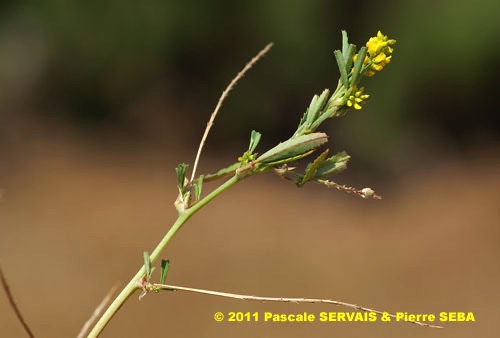
2
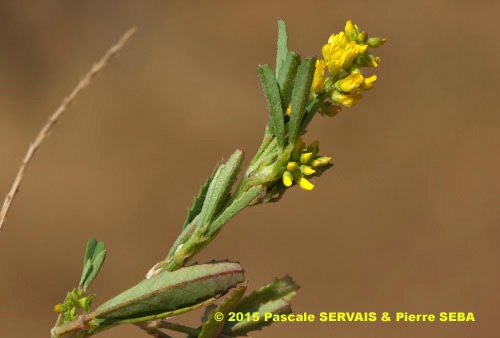
3
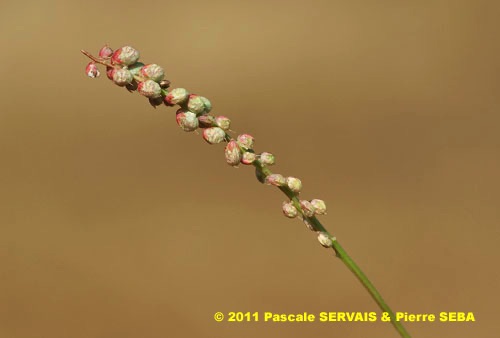
4
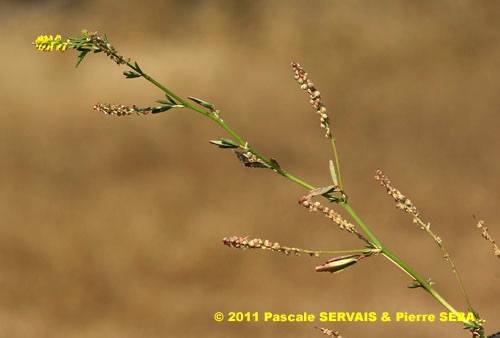
5
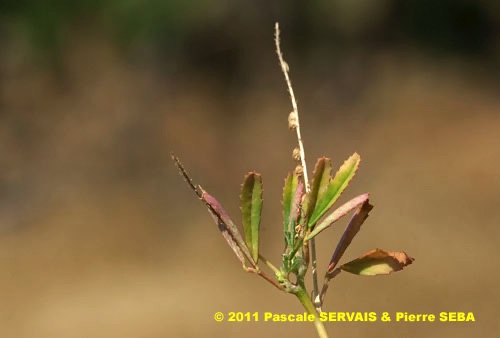
6
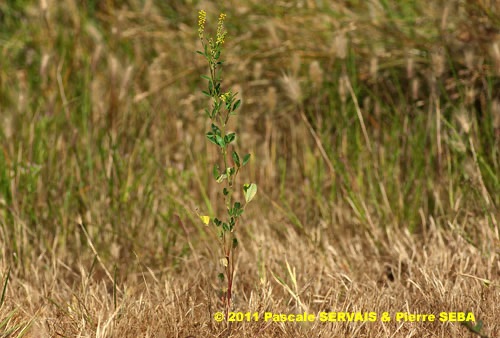
7
Étymologie / Etymology :
Melilotus : emprunt du grec ancien μελίλωτος, -ου (nom)
[ < μέλι, -ιτος (nom) = le miel + λωτός, -οῦ (nom) = le lotier ]
= le mélilot, nom donné à la plante par Dioscoride, médecin et
botaniste grec mort en 90 apr. J.-C., en référence à ses fleurs
mellifères semblables à celles du lotier.
Indicus : emprunt du latin indicus, -a, -um (adj.)
[ < India, -ae (nom) = l’Inde ] = de l’Inde, qui vient de l’Inde.
Melilotus : borrowed from Classical Greek μελίλωτος, -ου (noun)
[ < μέλι, -ιτος (noun) = honey + λωτός, -οῦ (noun) = bird’s-foot-trefoil ]
= melilot, name given to the plant by Dioscorides, Greek doctor and
botanist died in 90 AD, referring to its melliferous flowers similar to
those of the bird’s-foot-trefoil.
Indicus : borrowed from Latin indicus, -a, -um (adj)
[ < India, -ae (noun) = India ] = of or from India, which comes from
India.
Synonymes / Synonyms :
Trigonella smalii Coulot & Rabaute
Medicago parviflora (Desf.) E.H.L.Krause
Melilotus bonplandii Ten.
Melilotus boumetii Hornem.
Melilotus brachystachyus Willd. ex Spreng.
Melilotus diffusus Trévis.
Melilotus exaltatus Bianca
Melilotus indicus subsp. permixtus (Jord.) Rouy
Melilotus indicus var. bonplandii (Ten.) O.E.Schulz
Melilotus indicus var. exaltatus Biv. ex Rouy
Melilotus indicus var. laxiflorus Rouy
Melilotus indicus var. parvulus Rouy
Melilotus indicus var. permixtus (Jord.) P.Fourn.
Melilotus laevis Moench
Melilotus melilotus-indicus (L.) Asch. & Graebn.
Melilotus neapolitanus var. macrocarpus Rouy
Melilotus occidentalis Nutt. ex Torr. & A.Gray
Melilotus parviflorus Desf.
Melilotus permixtus Jord.
Melilotus polonicus Pers.
Melilotus reticulatus Pomel
Melilotus robinii Raf.
Melilotus tommasinii Jord.
Sertula indica (L.) Kuntze
Trifolium indicum L.
Noms vernaculaires / Common names :
Noms français / French names :
Mélilot à petites fleurs — Mélilot d’Inde —
Mélilot de l’Inde — Mélilot des Indes.
Nom grec / Greek name :
Μελίλωτος.
Noms anglais / English names :
Annual yellow sweetclover — Indian sweet-clover —
King island melilot — Small melilot — Small-flowered melilot —
Small-flowered sweet clover — Sourclover.
Noms allemands / German names :
Indische Honigklee — Kleinblütiger Honigklee —
Kleinblütiger Steinklee.
Noms espagnols / Spanish names :
Meliloto de flor pequeña — Trébol de olor — Trébol menor —
Trébol oloroso.
Nom italien / Italian name :
Meliloto d’India.
Habitat :
Lieux incultes - Lieux humides, mares - Sols sableux.
Waste ground - Damp places, ponds - Sandy soils.
Île / Island :
Tilos.
Hauteur / Height range :
De 10 cm à 50 cm.
From 10 cm to 50 cm.
Floraison / Flowering time :
D’avril à juin.
From April to June.
Groupe / Classification :
Dicotylédones.
Dicotyledons.
Pérennité / Lifespan :
Annuelle.
Annual.
Description :
Clés dichotomiques et descripteurs distinctifs des 2 espèces / Dichotomous keys and distinctive identifying features of the 2 species
Photo 1 :
Localisation / Location : Tilos, Livadia, Village
Date : 29/05/2011
GPS : Lat. 36,41001° N / Long. 27,39235° E / Alt. 8 m
Type : Photographie numérique / Digital Photograph (10 mégapixels)
Photo 2 :
Localisation / Location : Tilos, Livadia, Village
Date : 29/05/2011
GPS : Lat. 36,41001° N / Long. 27,39235° E / Alt. 8 m
Type : Photographie numérique / Digital Photograph (10 mégapixels)
Photo 3 :
Localisation / Location : Tilos, Livadia, Village
Date : 29/05/2011
GPS : Lat. 36,41001° N / Long. 27,39235° E / Alt. 8 m
Type : Photographie numérique / Digital Photograph (10 mégapixels)
Photo 4 :
Localisation / Location : Tilos, Livadia, Village
Date : 29/05/2011
GPS : Lat. 36,41001° N / Long. 27,39235° E / Alt. 8 m
Type : Photographie numérique / Digital Photograph (10 mégapixels)
Photo 5 :
Localisation / Location : Tilos, Livadia, Village
Date : 29/05/2011
GPS : Lat. 36,41001° N / Long. 27,39235° E / Alt. 8 m
Type : Photographie numérique / Digital Photograph (10 mégapixels)
Photo 6 :
Localisation / Location : Tilos, Livadia, Village
Date : 29/05/2011
GPS : Lat. 36,41001° N / Long. 27,39235° E / Alt. 8 m
Type : Photographie numérique / Digital Photograph (10 mégapixels)
Photo 7 :
Localisation / Location : Tilos, Livadia, Village
Date : 29/05/2011
GPS : Lat. 36,41001° N / Long. 27,39235° E / Alt. 8 m
Type : Photographie numérique / Digital Photograph (10 mégapixels)

Google Maps
Google Maps
Google Maps
Google Maps
Google Maps
Google Maps
Google Maps